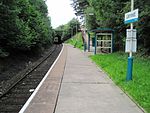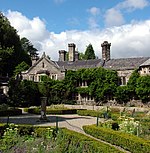St Grwst's Church, Llanrwst
15th-century church buildings in WalesChurch in Wales church buildingsChurches completed in the 1470sEnglish Gothic architecture in ConwyEngvarB from September 2013 ... and 5 more
Gothic Revival church buildings in WalesGothic architecture in WalesGrade I listed churches in Conwy County BoroughLlanrwstPaley and Austin buildings

St Grwst's Church, Llanrwst, is located in Church Street (Tan yr Eglwys), Llanrwst, Conwy, Wales. It is an active Church in Wales parish church and is part of the Aberconwy Mission Area in the archdeaconry of St Asaph, and the diocese of St Asaph. Its benefice is united with those of Llanddoged with Capel Garmon, Llansanffraid Glan Conwy, and Eglwysbach. The church is designated by Cadw as a Grade I listed building.
Excerpt from the Wikipedia article St Grwst's Church, Llanrwst (License: CC BY-SA 3.0, Authors, Images).St Grwst's Church, Llanrwst
Willow Street,
Geographical coordinates (GPS) Address External links Nearby Places Show on map
Geographical coordinates (GPS)
| Latitude | Longitude |
|---|---|
| N 53.1381 ° | E -3.7992 ° |
Address
Church of St Grwst
Willow Street
LL26 0ES , Llanrwst
Wales, United Kingdom
Open on Google Maps







